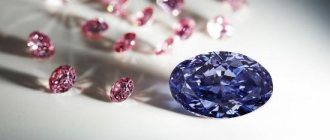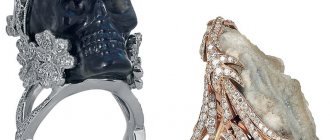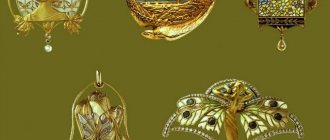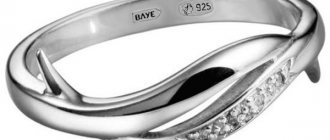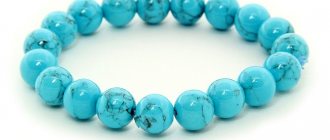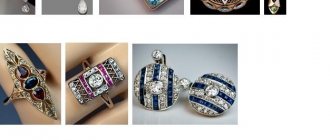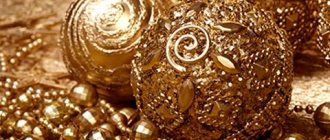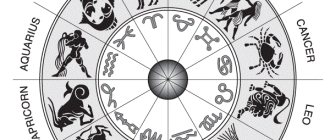Quote from Maya_Peshkova's message
Read in full In your quotation book or community!
,classicism,empire
Style is more than just a sense of wardrobe choice. The style reflects the stages of development of history in art. Simply put, it is the sum of visual techniques of a certain time and direction.
Styles replaced each other - sometimes thanks to the powers that be (Louis XV, Napoleon Bonaparte, Queen Victoria, Ludwig of Bavaria), and sometimes simply due to a decline in public interest. Styles that are centuries distant from us are considered to be “historical” (Gothic, Renaissance, Baroque, Classicism, Romanticism). And those that are 70 years or closer away from us can perhaps be considered “current” styles (cubism, primitivism, steampunk, and the like).
When describing the characteristics of a style, the following concepts are used: composition, line, color scheme, materials; in historical styles - ornament and its elements. Speaking of historical styles: “sometimes they come back” in the form of neo-styles - sometimes with great success (after all, technologies are improving). A striking example is the same Gothic. By the way, styles received their names very, very “retroactively”, often different in different countries.
For example, in the West (in England and countries that were influenced by the United Kingdom) the following classification of jewelry styles is accepted:
- Georgian (1714-1837) - “Georgian style” - the era of the reign of Kings George 1, 2, 3 and 4
- Victorian (1837-1901) - “Victorian style” - the era of the reign of Queen Victoria (1837-1890) the Romantic Period (1837-1861) (“romantic” period)
- the Grand Period (1861-1880) (“grand”)
- the Aesthetic Period (1880-1901)
So, looking back with hope at historical cinema (“Elizabeth: The Golden Age”, “Pirates of the Caribbean”, “Midshipmen” and the like), let’s try to start with the main historical styles - Baroque, Rococo, Classicism and Empire.
According to the Western classification, all these styles practically fit into the Georgian era that was dominant at that time.
Baroque style and its jewelry heritage
The picturesque and majestic Baroque style - “bizarre”, “irregular” in translation from Portuguese - arose in the 16th century in Italy. “Film Guides” on style - “Farinelli”, “Girl with a Pearl Earring”. The hallmark of this style is funny jewelry with irregularly shaped “baroque” sea pearls.
In relation to the jewelry art of this era, it is customary to distinguish Early Baroque (1600-1660), Late Baroque (1660-1725), and Rococo (1725-1775). In this article we consider Rococo as an independent style.
The reasons for the appearance and roots of this style are perhaps the following: the papacy decided to hit the Spaniards and French with the club of art (in a monumental and magnificent baroque design), who were then dictating the terms of politics to the Italians. The nobility of Italy compensated for the loss of power by demonstrating trumpeting luxury (unacceptable within the framework of the previous style - the Renaissance). Baroque is a riot of optimism, subordinated to symmetry.
Baroque features include:
- clear design (when the mass of convex small elements is arranged into a clearly readable symmetrical silhouette)
- rhythmic composition (subordination of elements to each other and to the artist’s entire plan)
- clear convex reliefs
- “dense” floral ornament, brightness of color
Baroque style jewelry
In Baroque jewelry, the most typical elements were gold (less often silver), multi-colored enamels and bright precious stones or large pearls. Marine pearls were in fashion, with unusual, including elongated shapes. Later, this type of pearl was given the name “Baroque pearl”.
Representatives of the nobility wore long multi-row strands of pearls and busy “Girandole” earrings (English: Girandole or Chandelier – (chandelier) earrings) with three pearl pendants.
Large or small brooches were used to decorate the neckline of the bodice and waist. Pearls and stones were sewn onto the dress along with ribbons.
Openwork brooches-slavages were attached to a neckband or on a deep neckline. Large brooches-bouquets or intertwined branches were typical. The brooch-bow with a pendant will be called the “brooch de Sevigne” (portrait above)
Clothes and shoes were decorated with precious buckles.
Decorated clothes and cameos
Art Nouveau or Art Nouveau style
Art Nouveau pendant by Luis Masriera
In the 90s of the 19th century, Art Nouveau (Art Nouveau) became popular - a new art that originated in Russia and France, and later conquered all of Europe. At first, jewelry in this style had Gothic and Japanese features or were made in a floral style (the use of floral and plant patterns). The style quickly became popular due to its brightness, imagery, and abundance of decor.
Advertising - Continued below
Many consider Art Nouveau a paradox in the jewelry craft because of the mixture of different styles: in Russia, Art Nouveau develops along with national techniques, and French masters focus on Japanese motifs. All this led to the fact that Art Nouveau decorations were unusual and unusual for those times.
At first, products in this style were created only for wealthy people in a single copy. In addition to plant themes, they began to use images of mythical characters, silhouettes of people, birds, and animals. Various jewelry enamel techniques were actively used.
Rococo style - French sophistication
To the ear, Rococo is similar to Baroque, but in appearance it has distinct differences. The birthplace of Rococo (or Rocaille) is France at the beginning of the 18th century (the film “Farewell My Queen” about Marie Antoinette (2012) is a film guide to this style).
The roots of this style are purely French: a longing for intimacy. Unlike the Italians, the French did not need the illusion of power; Rocaille (translated as “shell”) is a chamber style.
While preserving the picturesqueness of the Baroque, Rocaille moved away from color brightness, scale, and symmetry. The lines became smooth
Jewelry from Rococo times
Rococo features are asymmetry, smoothness, pastel colors, sophistication and intimacy. Compared to the jewelry art of Baroque times, in the Rococo era jewelry became more “frivolous” and airy. It seems as if the motifs of the jewelry simply do not fit into the given form and are trying to break out of there.
Jewelers are switching to the “brilliant” cut of diamonds (the author is considered to be the Venetian Vincenzo Peruzzi). The diamond excels. Now it is fashionable to set it not in gold, but in silver, using the pave setting method (when the product is studded with diamonds, like a bagel with poppy seeds). Parures (sets of jewelry similar in material, work, design) are becoming fashionable. Brioles earrings are popular - with movably attached long pendants - “drops” and “stars”. They create precious “bouquets”—the 18th century is called the “age of flowers and diamonds.”
The ladies' hairstyles are very intricate. Movable openwork pins are in fashion - “ziternadel” (from German zittern - tremble and nadel - pin). Asymmetrical aigrettes (feathered headdress, from the Latin - Egretta, a genus of white herons), graceful feathers, and sometimes bright butterflies. “Port bouquets” (jewelry “vases” for bouquets of fresh flowers) appeared. Men did not lag behind, decorating various orders, buckles of clothes and shoes, sword handles, and many key chains with diamonds.
But the ornate rocaille already contained the seeds of future classicism. For example, medallions with enamel miniatures; round or oval, discreet decor.
Gems and jewelry in clothing: in the Baroque and Rococo era. Part 4
Gems and jewelry in clothing: in the Baroque and Rococo era. Part 4In the 17th - 18th centuries, with the advent of a new style - Baroque, and then Rococo, in jewelry more and more attention began to be paid to color and pictorial effect. And if in the first half of the 17th century, jewelers were happy to experiment with enamels, creating real miniature masterpieces, then by the middle of the century His Majesty the stone returned to its position of strength. The natural shine, iridescence of the stone, its color and, of course, size were given extraordinary importance. Moreover, this concerned not only expensive diamonds, rubies and emeralds, but also ordinary gems. Garnet, amethyst, rock crystal, opal and other semi-precious stones are actively used. In the bed of the stone - caste - they begin to lay thin metal foil, thanks to which it better reflects light. The unprecedented influx of precious stones, primarily diamonds, that Europe experienced in the 17th and 18th centuries determined the fashion for this stone. It, like many other colored stones, was brought from Ceylon, India, Burma, as well as Brazil and Colombia. The diamond required a good cut, in which it showed all its brilliance and natural clarity. A diamond cut was developed for it, which was later used for other stones. Those for whom popular diamonds were unavailable had to resort to a trick - a transparent stone replaced rock crystal, tourmaline and other gems. Moreover, the diamonds themselves were not always transparent - yellowish, pinkish and bluish diamonds are becoming fashionable.
Photo 1. Brooch-bouquet of the late 18th century, in which inexpensive chrysoberyls imitate brilliant-cut diamonds. Portugal.
In the 17th - 18th centuries, the principle of dominance of beauty and quantity of stones over the skill of processing the metal part of the product appeared. The embossing, carving and other attributes of a well-crafted piece of jewelry are retained, but compared to stones they become less important. Popular and expensive diamonds are placed on silver items, side by side with fairly cheap gems - all for the sake of contrast and picturesque decoration. Such attention to the stone could not leave the art of cutting in place - it is growing every decade. The cabochon cut, widely used during the Middle Ages and the Renaissance, is becoming a thing of the past - now symmetry, regular lines and edges are in fashion. Experiments with different types of cuts are sometimes associated with interesting legends and historical facts. Thus, it is believed that the marquise cut was invented at the personal request of King Louis XV, who ruled France in the mid-18th century. In addition to his unreasonable rule, he was remembered in history for the phrase “After us, even a flood” and loud scandals due to his connection with the Marquise de Pompadour. In an effort to please his favorite, the king ordered a piece of jewelry to be made for her with a stone, the cut of which would resemble the graceful line of her plump lips. Instead of the usual round brilliant cut, the jewelers gave the stone an elongated shape, tapering towards the tips - exactly like the lips of the king’s favorite, folded for a kiss. The name of the cut was given by the title of Madame de Pompadour.
Photo 2. The marquise or marquise cut, invented in the mid-18th century.
In the 17th century, the fashion for unusual stones continued - only partially cut or having an original shape from nature. They collect semi-precious stones with veins and growths, patterns formed by nature, and insert them into jewelry and household items. Coral growths and insects frozen in amber are becoming popular, but most of the glory goes to pearls. The original shape of sea and river pearls gives rise to the most unusual pictures in the imagination of jewelers, which they reproduce in brooches, pendants, and earrings. Often such compositions are complemented with precious emeralds and rubies, as well as amethyst, agate, chalcedony, and tourmaline.
Photo 3. Gold salamander pendant with enamel, pearls, beryl. The central detail is an unusually shaped pearl. Made in Western Europe, presumably in Germany. Dates from the beginning of the 17th century.
The 18th century somewhat shifted fashion guidelines. Agates and turquoise are used more often; coral remains just as popular. Inserts made from exotic materials coming from Africa and the New World are in fashion: pieces of coconut bark, ostrich egg shells, fragments of mother-of-pearl shells. In the Baroque era, the range of jewelry that was used in everyday and festive life expanded. In addition to numerous necklaces, pendants, jewelry buttons, and hair accessories, watches are also being produced. The lush and overloaded Baroque style attaches particular importance to the brightness of the stones used and the abundance of details, which is why in this era semi-precious stones are used on a par with precious stones. The Rococo style that replaced it in the 18th century makes the lines more elegant, the composition more thoughtful, but also does not abandon a large number of details. The fashion in jewelry is set by France, the birthplace of the absolute monarchy - this form of government turned out to be not the best for the well-being of the people, but the most suitable for the development of jewelry art. The rich French court, with all its pomp and excess luxury, required a large amount of decorations that emphasized wealth and social status. Men wear rings, precious buttons and buckles - from the waist belt to boots or shoes, and have watches inlaid with gold and silver, often with diamond inserts. Women, in addition to the usual set of jewelry (beads, necklace, bracelet, rings, earrings), begin to wear new accessories. Aigrettes appear - special brooch-like hair decorations that secure ostrich and other decorative feathers. If earlier feather holders were present mainly on men's hats, now they have become an attribute of ladies' hairstyles - aigrettes were attached directly to the hair. They were decorated with citrine, garnet, rock crystal, onyx, and the ubiquitous diamonds.
Photo 4. Aigrette for ostrich feathers, decorated with diamonds and emeralds. XVIII century.
But the most popular decoration of the Baroque and Rococo era was undoubtedly the brooch. In a woman's suit, the brooch was present literally everywhere - it marked the center of the bodice of the dress and was attached to the sleeves, held ribbons and bows on the shoulders, and fastened the graceful folds of a full skirt, which was put on a special frame - a pannier. In addition to the already well-known circular brooches and animal-style jewelry, new motifs appear that are more suitable for the graceful era - bow brooches, flower brooches and entire flower bouquets. Other motifs were also used - images of fruits, ribbons and even arrows.
Photo 5. Gold brooch in the form of an arrow from the late 18th century. Decorated with large citrines, garnets, chrysoberyls.
A brooch in the form of a bow became popular back in the 17th century - then it was fashionable to attach satin ribbons to clothes, tie folds with them and decorate the bodice of a woman’s dress. One of the court ladies of King Louis XIII, known for her epistolary works, Madame de Sevigne, decided to make a metal bow with precious stones instead of ribbons - and ordered a brooch from jewelers. Known for her intelligence and beauty, she easily introduced the jewelry bow into court fashion. There was even a special term - brooch de Sevigne, which was used for brooches in the form of a bow with an ode or several pendants.
Photo 6. Brooch in the form of a bow with a pendant that belonged to Empress Catherine II. Made to special order by jeweler Leopold Pfisterer. Gold, small diamonds, spinel.
By the mid-to-late 18th century, it became customary to combine jewelry not only by the abundance of stones, but also by a single style of execution. Parures—sets of jewelry—came into fashion. A small parure could look like a set of a ring, earrings, a necklace and a comb in the hair decorated with stones; large parures could contain up to twenty jewelry items - including brooches, bracelets, pins for hairstyles and headdresses.
Photo 7. Austrian parure with peridots and diamonds, dating back to the 18th century.
The fashion for certain jewelry with stones was dictated not only by ladies' dresses and accessories, but also by purely male attributes. In the 17th - 18th centuries, as well as several centuries earlier, a man very rarely put his weapon aside - so rarely that it became an indispensable part of the court costume, which means it was decorated as richly as possible. Gem inserts on the hilts of swords, scabbards decorated with rubies, sapphires, agates and amethysts, a pendant studded with overlays with garnets, a belt embroidered with pearls - all this increased the number of precious and semi-precious stones in a man's suit. It also remained fashionable to simply embroider a doublet (outer short silk or brocade jacket) with pearls and decorate it with numerous brooches and precious clasps.
Photo 8. Portrait of George Villiers, Duke of Buckingham. By Mikael van Miereveld, early 17th century.
At the end of the 17th - 18th centuries, the image of flowers and bows ceased to be a purely female subject - men began to wear similar jewelry. The gift from Maria Theresa, Empress of Austria, to her husband is famous. Having decided not to waste time on trifles and not to waste money on brooches with flowers, she presented Emperor Franz Joseph with a whole jewelry bouquet with golden stems and leaves, as well as a huge number of precious and semi-precious stones. The materials for the stone flowers were rubies, emeralds, sapphires and countless semi-precious ornamental stones. There are only one and a half thousand amethysts in the bouquet, and there are no less other stones in it - agate, turquoise, citrines, onyxes, opals and other gems. This 30 cm high jewelry miracle was made by Michael Grosser in 1760 and is now kept in the Vienna Historical Museum.
Photo 9. A precious bouquet presented by Empress Maria Theresa of Austria to her husband. Golden leaves and stems, as well as several thousand precious and semi-precious stones.
Starting from the second half of the 17th century and to this day, special attention has been paid to amber in the jewelry of the best craftsmen. Its active export from the Baltic states to Europe made it possible to use it not only in jewelry, but also in some household items - snuff boxes, flowerpots, cups. In the 18th century, they tried to use amber with insects, flowers and plants frozen inside in rings, earrings, and necklaces. This miracle of nature’s preservation of living things was greatly appreciated in the era of love for curiosities. The fashion for amber has not bypassed Russia, the homeland of the richest deposits of this gem in Europe. The best confirmation of this is the Amber Room. If until the middle of the 17th century, both Europe and Russia were dominated by imported stones brought from India, Ceylon, and Africa, then from the 1630s to 1650s Russian precious, semiprecious and ornamental stones entered the arena. . In the 1630s, a deposit of malachite was discovered in the Urals, followed by many other colored stones. Since 1635, the Diamond Chamber began operating in the Moscow Kremlin, employing some of the best lapidaries in the region. Its products fully met the needs of the court and local nobility; stones cut in Moscow were also sold abroad. After Peter the Great's reforms, the number of cutting enterprises increased, and the export of Russian gems to Europe became constant. In contrast to the European fashion for a transparent stone - diamond, in Russia there is still a great love for semi-precious stones. They decorate ceremonial royal clothes and are present in almost all types of jewelry. The favorites of Russian Baroque are ruby, emerald, sapphire, garnet, amethyst, almandine, chrysolite, malachite, as well as the ubiquitous sea and river pearls of different diameters. Strengthening ties with Europe contributed to the exchange of experience and partly borrowing European fashion. To this day, the Diamond Fund of Russia preserves a parure composed of gold flowers studded with diamonds. The stones are placed on colored foil to have pink, blue and yellow tints.
Photo 10. Floral parure from the Diamond Fund of Russia, which uses a colored foil backing.
In the 18th century, at the Russian imperial court, a unique etiquette for wearing jewelry with stones appeared; they began to vary depending on the time of day when they were worn. Light amethysts, blue aquamarine and agate were considered morning. For daytime receptions and events, jewelry with gray agate, onyx, carnelian, and turquoise was worn. Parures with diamonds, rings, earrings, bracelets and tiaras with diamonds were worn only on holidays, on especially special occasions and always in the evening. However, not only diamonds were the favorites of the Russian tsars. In 1730, a new imperial crown was made for Anna Ioannovna, into which a hundred-gram red tourmaline was inserted. It served as a stand for a cross studded with diamonds. Most likely, the stone was mistaken for a large ruby, which is why it was awarded the royal crown.
Photo 11. Crown of Anna Ioannovna, made in St. Petersburg in 1730. Tourmaline, citrine, diamonds and other precious and semi-precious stones were used.
Red tourmaline was often confused with ruby. Thus, the Swedish king Gustav III in 1777 presented Catherine II with a real rarity - a large red stone of 255 carats, cut in the shape of a bunch of grapes. It was brought from Burma especially for the king, mistaking it for a ruby of extraordinary size. It was later discovered that the grape bunch was carved from red tourmaline.
Photo 12. Royal gift from Gustav III to Catherine II, which turned out to be a tourmaline rather than a ruby bunch of grapes. Red tourmaline, gold, hot enamel.
But Catherine II probably would not have been upset by such news - she herself was an admirer of gems and ornamental stones and owned one of the richest glyptoteks in Europe. The Empress especially loved cameos. This accessory began to come into fashion in the last quarter of the 18th century with the fashion for everything antique. Tiaras, combs, bracelets, necklaces, and even scarf pins began to be decorated with cameos. They were carved from two-color jasper, onyx, rhodonite, porphyrite and amazonite.
Photo 13. Large parure with cameos from the late 18th century.
Cameos, as well as a fascination with antiquity, its democratic ideals and the aesthetics of classicism, became popular at the end of the 18th century. With the Great French Revolution, a new era came to France and throughout the world. In architecture, painting, sculpture and, of course, jewelry, the period of neoclassicism began.
Author: All articles and videos
Date: Wednesday, September 10, 2014
Classicism style: lightness and playfulness are replaced by a reference to antiquity
Classicism (English Classicism - Neoclassicism) came in the second half of the 18th century as a calm balance of forms, harmonious proportions, restraint and orderliness of decor (in a word, no riot, even symmetrical). Film style guide - “Pride and Prejudice” 1995. In relation to jewelry, the era of classicism is considered to be the period from approximately 1760 to 1830.
The reasons for the appearance of this style are fatigue from court luxury and extravagance, the quantitative growth of representatives of the bourgeois class, as well as a very specific impulse - excavations in 1750-1760. Herculaneum and Pompeii, destroyed by Vesuvius.
Features of classicism in decor are the Greek meander, acanthus and laurel or oak leaves, geometrically adjusted rosettes and palmettes, medallions and other antique motifs.
Classicism in the jewelry of its time
(not to be confused with modern “classic style” jewelry)
During the heyday of classicism, women lost the abundance of jewelry, but other types of jewelry were highly valued. For example, round and oval brooches - they were used to pin fashionable cashmere shawls (worn over the finest clothes). Antique cameos (a carved stone or shell; a brooch made of such a stone or shell) or enamel portrait miniatures (surrounded by small diamonds or pearls) were inserted into the gold frames of brooches. The Napoleonic War played a very important role in the jewelry of that time - after it, a separate type of “mourning” jewelry appeared, for example, medallions with woven hair of deceased relatives, or enamel medallions and rings with motifs of grief and memory.
Ancient gems (precious stones with in-depth or convex carvings) from archaeological excavations of that time caused great excitement. The finds were inserted into brooches, rings, earrings, buckles, belts, and even into necklaces and tiaras. Rings were worn a lot, and at social events sometimes on all fingers. Naked hands were decorated with many gold hoops, often with a meander.
The head was decorated with gold hoops, often with an engraved meander. On special occasions, luxurious tiaras with diamonds and pearls were worn. The tiara (at that time the dominant feature of the parure) set the tone for the decor of all the decorations in the set. At the beginning of the 19th century in Europe and Russia, the technique of openwork filigree was revived. Necklaces were made from filigree, hair nets were woven, and parts of bracelets and necklaces were assembled into filigree. Gold and silver filigree earrings with pear-shaped pendants were popular.
Empire style - “imperial” classicism
The Empire style is called the final phase of classicism (the first decade of the 19th century). The name comes from the French empire - empire; this is the style of the empire of Napoleon Bonaparte (the reason for the appearance of this style is vaguely guessed in this fact). The Empire style is practically a copy of the decorative elements of the Roman Empire. If Rocaille moved away from the pomp of Baroque, the Empire style neglected the restraint of classicism.
Empire style features are relief details in the form of clearly drawn palmettes, lion masks, griffins, sphinxes, Egyptian motifs or various military-themed emblems (spirals, shields, arcs, eagles). From floristry - garlands, laurel and oak leaves, ears of corn and sheaves. A style of confident grandeur within the framework of artistic harmony. It is no coincidence that the Empire style was repeatedly (and almost universally) taken up by very different rulers.
